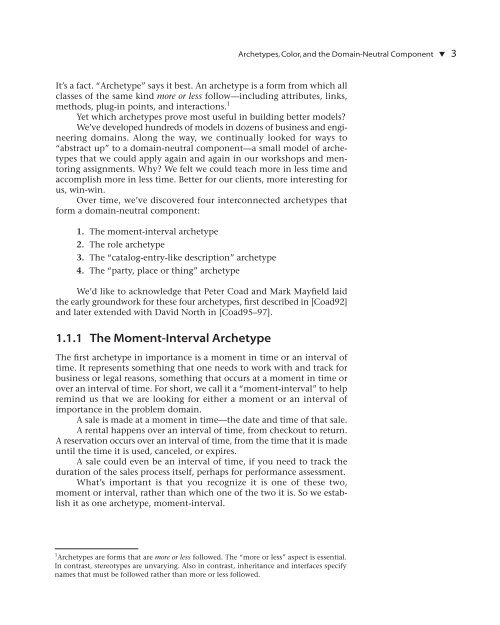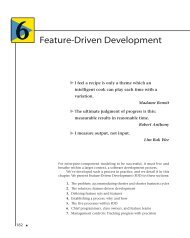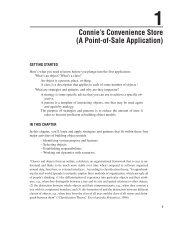Archetypes, Color, and the Domain-Neutral ... - Petercoad.com
Archetypes, Color, and the Domain-Neutral ... - Petercoad.com
Archetypes, Color, and the Domain-Neutral ... - Petercoad.com
Create successful ePaper yourself
Turn your PDF publications into a flip-book with our unique Google optimized e-Paper software.
<strong>Archetypes</strong>, <strong>Color</strong>, <strong>and</strong> <strong>the</strong> <strong>Domain</strong>-<strong>Neutral</strong> Component ▼ 3It’s a fact. “Archetype” says it best. An archetype is a form from which allclasses of <strong>the</strong> same kind more or less follow—including attributes, links,methods, plug-in points, <strong>and</strong> interactions. 1Yet which archetypes prove most useful in building better models?We’ve developed hundreds of models in dozens of business <strong>and</strong> engineeringdomains. Along <strong>the</strong> way, we continually looked for ways to“abstract up” to a domain-neutral <strong>com</strong>ponent—a small model of archetypesthat we could apply again <strong>and</strong> again in our workshops <strong>and</strong> mentoringassignments. Why? We felt we could teach more in less time <strong>and</strong>ac<strong>com</strong>plish more in less time. Better for our clients, more interesting forus, win-win.Over time, we’ve discovered four interconnected archetypes thatform a domain-neutral <strong>com</strong>ponent:1. The moment-interval archetype2. The role archetype3. The “catalog-entry-like description” archetype4. The “party, place or thing” archetypeWe’d like to acknowledge that Peter Coad <strong>and</strong> Mark Mayfield laid<strong>the</strong> early groundwork for <strong>the</strong>se four archetypes, first described in [Coad92]<strong>and</strong> later extended with David North in [Coad95–97].1.1.1 The Moment-Interval ArchetypeThe first archetype in importance is a moment in time or an interval oftime. It represents something that one needs to work with <strong>and</strong> track forbusiness or legal reasons, something that occurs at a moment in time orover an interval of time. For short, we call it a “moment-interval” to helpremind us that we are looking for ei<strong>the</strong>r a moment or an interval ofimportance in <strong>the</strong> problem domain.A sale is made at a moment in time—<strong>the</strong> date <strong>and</strong> time of that sale.A rental happens over an interval of time, from checkout to return.A reservation occurs over an interval of time, from <strong>the</strong> time that it is madeuntil <strong>the</strong> time it is used, canceled, or expires.A sale could even be an interval of time, if you need to track <strong>the</strong>duration of <strong>the</strong> sales process itself, perhaps for performance assessment.What’s important is that you recognize it is one of <strong>the</strong>se two,moment or interval, ra<strong>the</strong>r than which one of <strong>the</strong> two it is. So we establishit as one archetype, moment-interval.1 <strong>Archetypes</strong> are forms that are more or less followed. The “more or less” aspect is essential.In contrast, stereotypes are unvarying. Also in contrast, inheritance <strong>and</strong> interfaces specifynames that must be followed ra<strong>the</strong>r than more or less followed.




